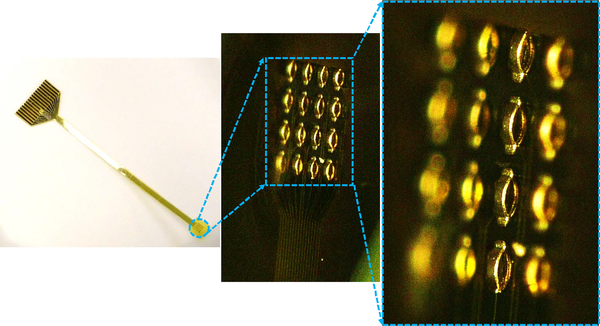3D Multi-Electrode Arrays
Type: Electrophysiology / Probes,
Keywords: Flexible multi-electrode array (MEA), Electromyography electrodes, 3D MEA device, Electromyogram (EMG) recording, Neurophysiology, Motor system

Micro-scale EMG arrays for recording single- and multi-unit activity
Micro-scale EMG arrays for recording single- and multi-unit activity from muscle populations, and algorithms for analyzing the resulting data.
*By developing advanced nanofabrication tools for manufacturing ultra-dense, ultra-flexible electrode arrays, we are creating a new class of electromyography (EMG) electrodes capable of recording large populations of single-unit recordings from muscle fibers during behavior.
*Developing devices for humans, songbirds, mice, rats, frogs, and nonhuman primates.
*Ensure flexibility and biocompatibility of the fabricated three-dimensional (3D) multi-electrode array (MEA) devices.
*Flexible 3D MEA for high signal-to-noise (SNR) in vivo electromyogram recordings.
*Developed microscale, flexible, high-density electrode arrays that sit on the surface of individual muscles to record EMG signals.
*The electrode exposures ranged from 25 to 300 μm in diameter and were separated by as little as 25 μm.
*Flexible 3D MEAs capable of high SNR EMG recordings from the muscles of multiple species.
*Able to acquire high-quality EMG recordings from 32 locations simultaneously during quiet respiration in eight male Bengalese finches.
* Humans
* Songbirds
* Mice
* Rats
* Frogs
* Nonhuman primates
*SNR measurements from the fabricated 3D electrode show up to a 7x improvement as compared to the 2D MEAs.
*Height of the 3D electrodes can easily be modulated by changing the film thickness of the spin coated photoresist.
*3D MEAs yielded higher SNR measurements over a longer duration of time as compared to a 2D array.
*Important for detecting and analyzing smaller units which are otherwise lost in noise.
*Some of the improvement may have been due to better electrical isolation as excess liquid dried around the recording site.
*With better signal fidelity, individual units can be identified more reliably and for longer periods of time, which will allow more advanced analysis techniques that can be used to understand how nervous systems control behavior.
*High specificity and impedance of individual electrodes. *Able to extract single-motor unit data in some cases.
* Designs have only been fabricated for a subset of muscle groups of interest to the BRAIN Initiative community
* Lu J, Williams M, Jacob AL, Chung B, Sober S, Bakir MS (2022). High-performance Flexible Microelectrode Array with PEDOT:PSS Coated 3D Micro-cones for Electromyographic Recording. IEEE Engineering in Medicine and Biology Society (EMBS).
* Zia M, Chung B, Sober S, Bakir MS (2020). Flexible Multielectrode Arrays With 2-D and 3-D Contacts for In Vivo Electromyography Recording. IEEE Transactions on Components, Packaging, and Manufacturing Technology.
* Zia M, Chung B, Sober SJ, Bakir MS (2018). Fabrication and Characterization of 3D Multi-Electrode Array on Flexible Substrate for In Vivo EMG Recording from Expiratory Muscle of Songbird. Tech. Dig. Int. Electron Devices Meet.
* Srivastava KH, Holmes CM, Vellema M, Pack AR, Elemans CP, Nemenman I, Sober SJ (2017). Motor Control by Precisely Timed Spike Patterns. Proc. Natl. Acad. Sci.
* https://www.ncbi.nlm.nih.gov/pmc/articles/PMC7150534/
Sam Sober, Associate Professor
Emory University
FUNDING SOURCE(S)
McKnight Foundation Technological Innovations in Neuroscience Award, NIH grant R01NS109237, the Simons Foundation

